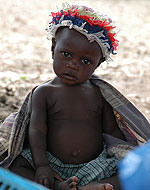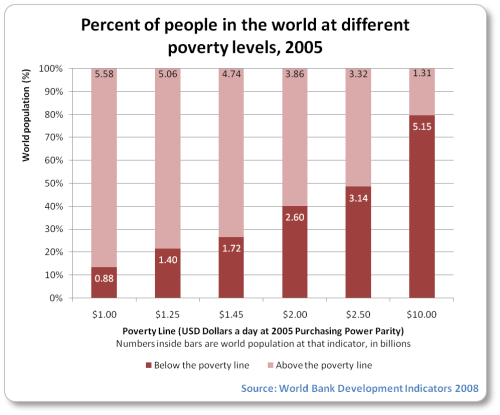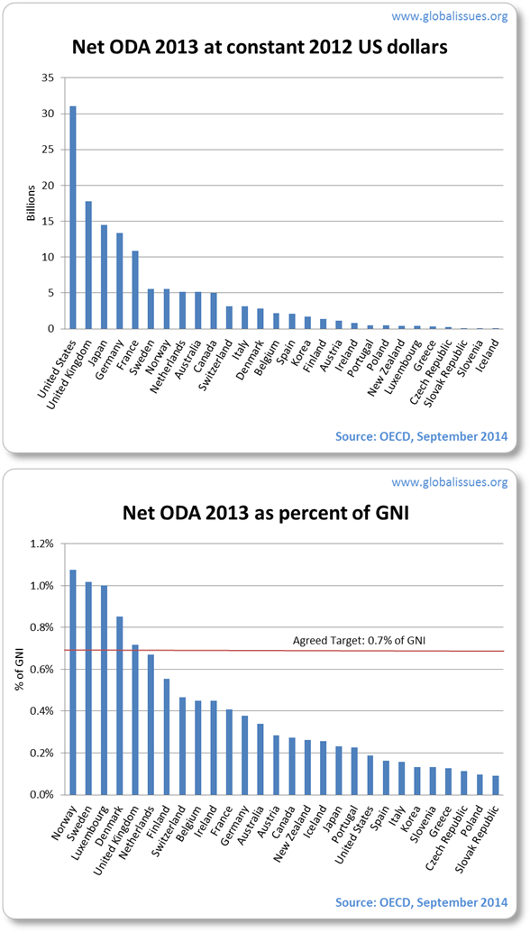Causes of Poverty
Author and Page information
- This page: https://daihochutech.site/issue/2/causes-of-poverty.
- To print all information (e.g. expanded side notes, shows alternative links), use the print version:
- Almost half the world — over 3 billion people — live on less than $2.50 a day.
- The GDP (Gross Domestic Product) of the 41 Heavily Indebted Poor Countries (567 million people) is less than the wealth of the world’s 7 richest people combined.
- Nearly a billion people entered the 21st century unable to read a book or sign their names.
- Less than one per cent of what the world spent every year on weapons was needed to put every child into school by the year 2000 and yet it didn’t happen.
- 1 billion children live in poverty (1 in 2 children in the world). 640 million live without adequate shelter, 400 million have no access to safe water, 270 million have no access to health services. 10.6 million died in 2003 before they reached the age of 5 (or roughly 29,000 children per day).
Poverty is the state for the majority of the world’s people and nations. Why is this? Is it enough to blame poor people for their own predicament? Have they been lazy, made poor decisions, and been solely responsible for their plight? What about their governments? Have they pursued policies that actually harm successful development? Such causes of poverty and inequality are no doubt real. But deeper and more global causes of poverty are often less discussed.
Behind the increasing interconnectedness promised by globalization are global decisions, policies, and practices. These are typically influenced, driven, or formulated by the rich and powerful. These can be leaders of rich countries or other global actors such as multinational corporations, institutions, and influential people.
In the face of such enormous external influence, the governments of poor nations and their people are often powerless. As a result, in the global context, a few get wealthy while the majority struggle.
These next few articles and sections explore various poverty issues in more depth:
14 articles on “Causes of Poverty” and 6 related issues:
Poverty Facts and Stats
Most of humanity lives on just a few dollars a day. Whether you live in the wealthiest nations in the world or the poorest, you will see high levels of inequality.
The poorest people will also have less access to health, education and other services. Problems of hunger, malnutrition and disease afflict the poorest in society. The poorest are also typically marginalized from society and have little representation or voice in public and political debates, making it even harder to escape poverty.
By contrast, the wealthier you are, the more likely you are to benefit from economic or political policies. The amount the world spends on military, financial bailouts and other areas that benefit the wealthy, compared to the amount spent to address the daily crisis of poverty and related problems are often staggering.
Some facts and figures on poverty presented in this page are eye-openers, to say the least.
Read “Poverty Facts and Stats” to learn more.
Structural Adjustment—a Major Cause of Poverty
Cutbacks in health, education and other vital social services around the world have resulted from structural adjustment policies prescribed by the International Monetary Fund (IMF) and the World Bank as conditions for loans and repayment. In addition, developing nation governments are required to open their economies to compete with each other and with more powerful and established industrialized nations. To attract investment, poor countries enter a spiraling race to the bottom to see who can provide lower standards, reduced wages and cheaper resources. This has increased poverty and inequality for most people. It also forms a backbone to what we today call globalization. As a result, it maintains the historic unequal rules of trade.
Read “Structural Adjustment—a Major Cause of Poverty” to learn more.
Poverty Around The World
 Around the world, in rich or poor nations, poverty has always been present.
Around the world, in rich or poor nations, poverty has always been present.
In most nations today, inequality—the gap between the rich and the poor—is quite high and often widening.
The causes are numerous, including a lack of individual responsibility, bad government policy, exploitation by people and businesses with power and influence, or some combination of these and other factors.
Many feel that high levels of inequality will affect social cohesion and lead to problems such as increasing crime and violence.
Inequality is often a measure of relative poverty. Absolute poverty, however, is also a concern. World Bank figures for world poverty reveals a higher number of people live in poverty than previously thought.
For example, the new poverty line is defined as living on the equivalent of $1.25 a day. With that measure based on latest data available (2005), 1.4 billion people live on or below that line.
Furthermore, almost half the world—over three billion people—live on less than $2.50 a day and at least 80% of humanity lives on less than $10 a day:
Read “Poverty Around The World” to learn more.
Today, around 21,000 children died around the world


Images © UNICEF
Around 21,000 children die every day around the world.
That is equivalent to:
- 1 child dying every 4 seconds
- 14 children dying every minute
- A 2011 Libya conflict-scale death toll every day
- A 2010 Haiti earthquake occurring every 10 days
- A 2004 Asian Tsunami occurring every 11 days
- An Iraq-scale death toll every 19–46 days
- Just under 7.6 million children dying every year
- Some 92 million children dying between 2000 and 2010
The silent killers are poverty, easily preventable diseases and illnesses, and other related causes. Despite the scale of this daily/ongoing catastrophe, it rarely manages to achieve, much less sustain, prime-time, headline coverage.
Read “Today, around 21,000 children died around the world” to learn more.
World Hunger and Poverty
Meaningful long-term alleviation of hunger is rooted in the alleviation of poverty, as poverty leads to hunger. World hunger is a terrible symptom of world poverty. If efforts are only directed at providing food, or improving food production or distribution, then the structural root causes that create hunger, poverty and dependency would still remain. While resources and energies are deployed to relieve hunger through technical measures such as improving agriculture, and as important as these are, inter-related issues such as poverty means that political solutions are likely required as well for meaningful and long term hunger alleviation.
Read “World Hunger and Poverty” to learn more.
Food Dumping [Aid] Maintains Poverty
Food aid (when not for emergency relief) can actually be very destructive on the economy of the recipient nation and contribute to more hunger and poverty in the long term. Free, subsidized, or cheap food, below market prices undercuts local farmers, who cannot compete and are driven out of jobs and into poverty, further slanting the market share of the larger producers such as those from the US and Europe. Many poor nations are dependent on farming, and so such food aid
amounts to food dumping. In the past few decades, more powerful nations have used this as a foreign policy tool for dominance rather than for real aid.
Read “Food Dumping [Aid] Maintains Poverty” to learn more.
Food and Agriculture Issues
 Food and agriculture goes to the heart of our civilizations. Religions, cultures and even modern civilization have food and agriculture at their core. For an issue that goes to the heart of humanity it also has its ugly side.
Food and agriculture goes to the heart of our civilizations. Religions, cultures and even modern civilization have food and agriculture at their core. For an issue that goes to the heart of humanity it also has its ugly side.
This issue explores topics ranging from the global food crisis of 2008, to issues of food aid, world hunger, food dumping and wasteful agriculture such as growing tobacco, sugar, beef, and more.
Read “Food and Agriculture Issues” to learn more.
Trade, Economy, & Related Issues
Read “Trade, Economy, & Related Issues” to learn more.
Corruption
 We often hear leaders from rich countries telling poor countries that aid and loans will only be given when they show they are stamping out corruption.
We often hear leaders from rich countries telling poor countries that aid and loans will only be given when they show they are stamping out corruption.
While that definitely needs to happen, the rich countries themselves are often active in the largest forms of corruption in those poor countries, and many economic policies they prescribe have exacerbated the problem.
Corruption in developing countries definitely must be high on the priority lists (and is increasingly becoming so in the wake of the global financial crisis), but so too must it be on the priority lists of rich countries.
Read “Corruption” to learn more.
Tax Avoidance and Tax Havens; Undermining Democracy
 Through tax havens, transfer pricing and many other policies — both legal and illegal — billions of dollars of tax are avoided. The much-needed money would helped developing (and developed) countries provide important social services for their populations.
Through tax havens, transfer pricing and many other policies — both legal and illegal — billions of dollars of tax are avoided. The much-needed money would helped developing (and developed) countries provide important social services for their populations.
Some tax avoidance, regardless of how morally objectionable it may be to some people, is perfectly legal, and the global super elite are able to hide away trillions of dollars, resulting in massive losses of tax revenues for cash-strapped governments who then burden ordinary citizens further with austerity measures during economic crisis, for example. Yet these super elite are often very influential in politics and business. In effect, they are able to undermine democracy and capitalism at the same time.
As the global financial crisis has affected many countries, tackling tax avoidance would help target those more likely to have contributed to the problem while avoid many unnecessary austerity measures that hit the poorest so hard. But despite rhetoric stating otherwise, it does not seem to high on the agenda of many governments as you might think.
Read “Tax Avoidance and Tax Havens; Undermining Democracy” to learn more.
Foreign Aid for Development Assistance
In 1970, the world’s rich countries agreed to give 0.7% of their gross national income as official international development aid, annually.
Since that time, billions have certainly been given each year, but rarely have the rich nations actually met their promised target.
For example, the US is often the largest donor in dollar terms, but ranks amongst the lowest in terms of meeting the stated 0.7% target.
Furthermore, aid has often come with a price of its own for the developing nations. Common criticisms, for many years, of foreign aid, have included the following:
- Aid is often wasted on conditions that the recipient must use overpriced goods and services from donor countries
- Most aid does not actually go to the poorest who would need it the most
- Aid amounts are dwarfed by rich country protectionism that denies market access for poor country products while rich nations use aid as a lever to open poor country markets to their products
- Large projects or massive grand strategies often fail to help the vulnerable; money can often be embezzled away.
This article explores who has benefited most from this aid, the recipients or the donors.
Read “Foreign Aid for Development Assistance” to learn more.
Causes of Hunger are related to Poverty
There are many inter-related issues causing hunger, which are related to economics and other factors that cause poverty. They include land rights and ownership, diversion of land use to non-productive use, increasing emphasis on export-oriented agriculture, inefficient agricultural practices, war, famine, drought, over-fishing, poor crop yields, etc. This section introduces some of these issues.
Read “Causes of Hunger are related to Poverty” to learn more.
United Nations World Summit 2005
The UN World Summit for September 2005 is supposed to review progress since the Millennium Declaration, adopted by all Member States in 2000. However, the US has proposed enormous changes to an outcome document that is to be signed by all members. There are changes on almost all accounts, including striking any mention of the Millennium Development Goals, that aim for example, to halve poverty and world hunger by 2015. This has led to concerns that the outcome document will be weakened. Developing countries are also worried about stronger text on human rights and about giving the UN Security Council more powers.
Read “United Nations World Summit 2005” to learn more.
IMF & World Bank Protests, Washington D.C.
To complement the public protests in Seattle, the week leading up to April 16th/17th 2000 saw the other two global institutions, the International Monetary Fund (IMF) and World Bank, as the focus of renewed protests and criticisms in Washington, D.C. The purpose of the mass demonstrations was to protest against the current form of globalization, which is seen as unaccountable, corporate-led, and non-democratic, and to show the link between poverty and the various policies of the IMF and the World Bank.
Read “IMF & World Bank Protests, Washington D.C.” to learn more.
Economic Democracy
This next page is a reposting of a flyer about a new book from J.W. Smith and the Institute for Economic Democracy, whom I thank for their kind permission. The book is called Economic Democracy: The Political Struggle Of The 21st Century. Typically on this site, I do not advertise books etc, (although I will cite from and link to some, where relevant). However, in this case, I found that the text in the flyer provides an excellent summary of poverty's historic roots, as well as of the multitude of issues that cause poverty. (Please also note that I do not make any proceeds from the sale of this book in any way.)
Read “Economic Democracy” to learn more.
Poverty Links for More Information
Links to other sites discussion issues on trade, the global economy, poverty and other related issues.
Read “Poverty Links for More Information” to learn more.
Trade, Economic Links For More Information
Read “Trade, Economic Links For More Information” to learn more.
World hunger related links for more information
Links to web sites and articles that discuss world hunger, the relationship between populations and hunger, of poverty and hunger, agricultural issues, land rights and so on.
Read “World hunger related links for more information” to learn more.
Sustainable Development
Read “Sustainable Development” to learn more.
Aid
 There are numerous forms of aid, from humanitarian emergency assistance, to longer term development aid. Some provide food aid, or military assistance, but all these forms of aid seem to be accompanied with criticism, either around inefficiency of delivery, or of political agendas or more. This section attempts to look at some of these issues.
There are numerous forms of aid, from humanitarian emergency assistance, to longer term development aid. Some provide food aid, or military assistance, but all these forms of aid seem to be accompanied with criticism, either around inefficiency of delivery, or of political agendas or more. This section attempts to look at some of these issues.
Read “Aid” to learn more.
Author and Page Information
- Created:
- Last updated:
 Global Issues
Global Issues
